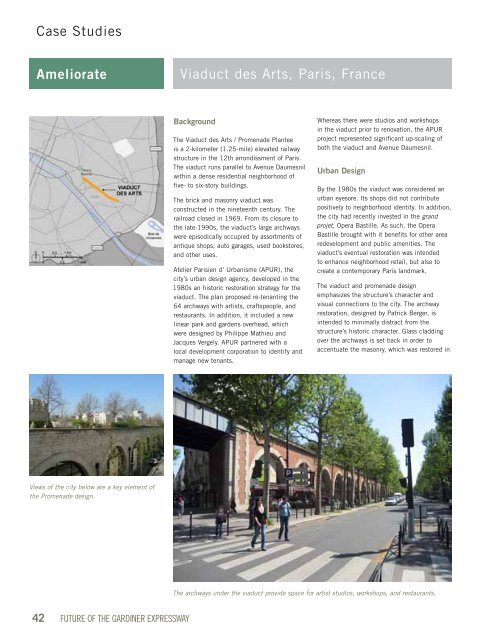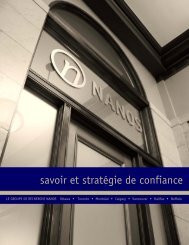Future of the Gardiner Expressway - Nanos Research
Future of the Gardiner Expressway - Nanos Research
Future of the Gardiner Expressway - Nanos Research
You also want an ePaper? Increase the reach of your titles
YUMPU automatically turns print PDFs into web optimized ePapers that Google loves.
Case StudiesAmeliorateViaduct des Arts, Paris, FranceBackgroundThe Viaduct des Arts / Promenade Planteeis a 2-kilometer (1.25-mile) elevated railwaystructure in <strong>the</strong> 12th arrondissment <strong>of</strong> Paris.The viaduct runs parallel to Avenue Daumesnilwithin a dense residential neighborhood <strong>of</strong>five- to six-story buildings.The brick and masonry viaduct wasconstructed in <strong>the</strong> nineteenth century. Therailroad closed in 1969. From its closure to<strong>the</strong> late-1990s, <strong>the</strong> viaduct’s large archwayswere episodically occupied by assortments <strong>of</strong>antique shops, auto garages, used bookstores,and o<strong>the</strong>r uses.Atelier Parisien d’ Urbanisme (APUR), <strong>the</strong>city’s urban design agency, developed in <strong>the</strong>1980s an historic restoration strategy for <strong>the</strong>viaduct. The plan proposed re-tenanting <strong>the</strong>64 archways with artists, craftspeople, andrestaurants. In addition, it included a newlinear park and gardens overhead, whichwere designed by Philippe Mathieu andJacques Vergely. APUR partnered with alocal development corporation to identify andmanage new tenants.Whereas <strong>the</strong>re were studios and workshopsin <strong>the</strong> viaduct prior to renovation, <strong>the</strong> APURproject represented significant up-scaling <strong>of</strong>both <strong>the</strong> viaduct and Avenue Daumesnil.Urban DesignBy <strong>the</strong> 1980s <strong>the</strong> viaduct was considered anurban eyesore. Its shops did not contributepositively to neighborhood identity. In addition,<strong>the</strong> city had recently invested in <strong>the</strong> grandprojet, Opera Bastille. As such, <strong>the</strong> OperaBastille brought with it benefits for o<strong>the</strong>r arearedevelopment and public amenities. Theviaduct’s eventual restoration was intendedto enhance neighborhood retail, but also tocreate a contemporary Paris landmark.The viaduct and promenade designemphasizes <strong>the</strong> structure’s character andvisual connections to <strong>the</strong> city. The archwayrestoration, designed by Patrick Berger, isintended to minimally distract from <strong>the</strong>structure’s historic character. Glass claddingover <strong>the</strong> archways is set back in order toaccentuate <strong>the</strong> masonry, which was restored inViews <strong>of</strong> <strong>the</strong> city below are a key element <strong>of</strong><strong>the</strong> Promenade design.The archways under <strong>the</strong> viaduct provide space for artist studios, workshops, and restaurants.42<strong>Future</strong> <strong>of</strong> <strong>the</strong> <strong>Gardiner</strong> <strong>Expressway</strong>



